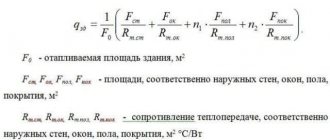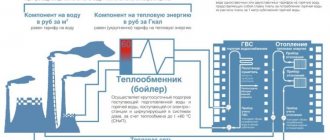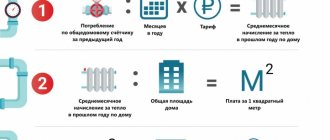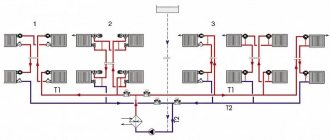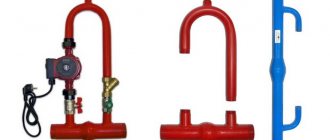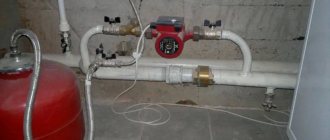Introduction
Requirements for determining the heat loads of consumers when developing heat supply schemes are reflected in the following regulatory and legislative acts:
- Federal Law of the Russian Federation of July 27, 2010 No. 190-FZ;
- Order of the Ministry of Regional Development of the Russian Federation dated February 28, 2009 No. 610;
Contract loads are usually calculated based on design data. Design heating loads mainly depend on the calculated parameters of the microclimate of the premises, the calculated temperature of the outside air during the heating period (assumed to be equal to the temperature of the coldest five-day period with a probability of 0.92 according to 8. SP 131.13330.2012) and the thermal insulation characteristics of enclosing structures. Design loads on hot water supply depend on the volume of hot water consumption and its design temperature.
Over the past 20-30 years, many of the parameters and characteristics listed above have changed several times. Methods for calculating thermal loads and requirements for thermal protection of enclosing structures have changed. In particular, the energy efficiency class of apartment buildings (ABCs) is determined based on a comparison (determining the deviation value) of actual or calculated (for newly built, reconstructed and overhauled ABMs) values of the indicator of specific annual consumption of energy resources, reflecting the specific consumption of energy resources for heating, ventilation, hot water supply and basic values of the specific consumption of energy resources in apartment buildings. In this case, the actual (calculated) values must be brought to the design conditions for comparability with the basic values. The actual values of the specific annual consumption of energy resources are determined based on the readings of common house meters.
The climate itself has also changed, as a result of which, for example, for St. Petersburg, the standard design temperature of the outside air has increased over thirty years, from –26 °C to –24 °C, the design duration of the heating period has decreased by 6 days, and the average The temperature of the heating period increased by 0.5 °C (from –1.8 to –1.3 °C).
In addition to the above factors, consumers of thermal energy themselves contribute to energy-saving measures, for example, by replacing wooden windows in apartments with more airtight plastic ones.
All these changes, taken together, contribute to the fact that the actual heat consumption and contractual heat loads of thermal energy consumers differ.
Examples of developed Heat Supply Schemes for a number of large settlements (for example, Nizhny Novgorod) have shown that if the contractual load (the load established in heat supply contracts) is taken as the actual load, this creates an excess capacity reserve of heat supply organizations. A significant portion of the load in this case turns out to be unclaimed, but at the same time constant operating costs remain, which negatively affects the efficiency of heat supply organizations (TSO) and the consumer of thermal energy.
The Strategy notes that the currently used technology for planning heat supply systems leads to unnecessary investments, the creation of excess thermal power in all elements of energy systems and the preservation of a low level of efficiency of the entire Russian energy sector.
The relevance of the topic raised in the article is due to the lack of methods in the current regulatory and legislative acts for determining actual heat loads in the design elements of the territorial division at design outdoor temperatures, the problems of reconciling the actual heat loads used for investment planning in heat supply schemes with TCO, as well as the consequences of incorrect analysis heat loads of consumers established in heat supply contracts.
Legal grounds for recalculating heat load
The right of consumers to calculate heat loads is secured
- in each standard contract for the supply of thermal energy, as well as
- in the order of the Ministry of Regional Development of the Russian Federation dated December 28, 2009 No. 610 “On approval of the rules for establishing and changing (revising) heat loads.”
Order No. 610 of the Ministry of Regional Development establishes that in order to revise contractual values, it is necessary to develop a technical report with calculations of heat loads.
The report must justify the change or reduction in the thermal load for the facility.
Also, Order No. 610 establishes that the calculation of the heat load for heating, ventilation and hot water supply can be revised after the implementation of energy-saving measures, namely, after:
- major repairs,
- reconstruction of internal engineering networks, which helps reduce losses through insulation and leaks,
- increasing the thermal protection of a building or facility,
- implementation of other energy-saving measures.
Here you can download the order of the Ministry of Regional Development of the Russian Federation dated December 28, 2009 No. 610 “On approval of the rules for establishing and changing (revising) heat loads.”
Which heating system for a private home is better and why?
An autonomous heating system for a private house is structurally composed of a boiler, radiators and a closed circular pipeline through which the coolant (except air) moves. Based on the type of coolant, the following types of heating are distinguished:
| Coolant | Advantages | Flaws |
| 1. Water (water or antifreeze is used) | Cost-effectiveness, availability of coolant, its low cost and safety of the system. | The rooms take quite a long time to warm up. In winter, neither planned nor emergency shutdown of the water system should be allowed, because at sub-zero temperatures the pipes will burst. |
| 2. Steam | Low inertia (rooms warm up immediately after switching on), energy efficiency. | Noisy, difficulties with regulating room temperature, the need to close pipes and radiators, high demands on the quality of pipes and radiators. |
| 3. Air | High efficiency, no costs for pipes and radiators, low inertia. This is an ideal option for a summer residence. | The air dries out, there are difficulties with the air supply (warm air rises, but the temperature below remains cold). |
Boilers differ in the type of fuel. You can talk for a long time about which heating to choose for a private home, go through the options and find their own advantages and disadvantages in each. To present the information more clearly and summarize the results, we suggest considering a comparative table.
| Coolant | Advantages | Flaws |
| 1. Gas | Comfortable operation (fully automatic system), large selection of boilers (single-circuit and double-circuit, wall-mounted and floor-mounted, convection and condensation), low operating costs, high efficiency, durability. | Limited accessibility (gas supply is not available everywhere), complexity of installing the system, the need for design and paperwork, high level of danger (leakage cannot be ruled out), maintenance costs. |
| 2. Electric | Availability of a heat source, low cost of equipment and installation, absence of a chimney and environmental friendliness, efficiency, comfort during operation, safety, high efficiency. | There is always a possibility of interruptions in power supply (it is advisable to have an alternative source of heating), it is necessary to comply with the requirements for the electrical network, the cost of electricity in some regions of Russia is quite high. |
| 3. Solid fuel | Low cost of energy, large selection of fuel types (coal, firewood, pellets, briquettes), availability of fuel in any region of Russia. | The need to load fuel manually, low efficiency, costs for cleaning and maintenance of the boiler and chimney, there must be a room for storing fuel. |
| 4. Liquid fuel | Low cost of fuel, can run on diesel fuel, fuel oil, waste oil, system autonomy, good efficiency. | A separate boiler room with a fuel storage tank is needed; combustion products may enter the room (depending on the boiler and the project), and requires regular maintenance and cleaning. |
| 5. Combined | Versatility. Cost-effectiveness and the ability to use the most profitable and practical energy carrier, quick payback. You can choose a single-circuit, double-circuit boiler, connect a boiler or a heated floor system. | A bulky boiler, a technically complex unit with a large amount of additional equipment. High cost of the system and installation. |
Average calculation and accurate
Taking into account the described factors, the average calculation is carried out according to the following scheme. If per 1 sq. m requires 100 W of heat flow, then a room of 20 sq. m should receive 2,000 watts. A radiator (popular bimetallic or aluminum) of eight sections produces about 150 W. Divide 2,000 by 150, we get 13 sections. But this is a rather enlarged calculation of the thermal load.
The exact one looks a little scary. Nothing complicated really. Here's the formula:
- q1 – type of glazing (regular = 1.27, double = 1.0, triple = 0.85);
- q2 – wall insulation (weak or absent = 1.27, wall laid with 2 bricks = 1.0, modern, high = 0.85);
- q3 – ratio of the total area of window openings to the floor area (40% = 1.2, 30% = 1.1, 20% - 0.9, 10% = 0.8);
- q4 – street temperature (the minimum value is taken: -35 o C = 1.5, -25 o C = 1.3, -20 o C = 1.1, -15 o C = 0.9, -10 o C = 0.7);
- q5 – number of external walls in the room (all four = 1.4, three = 1.3, corner room = 1.2, one = 1.2);
- q6 – type of calculation room above the calculation room (cold attic = 1.0, warm attic = 0.9, heated residential room = 0.8);
- q7 – ceiling height (4.5 m = 1.2, 4.0 m = 1.15, 3.5 m = 1.1, 3.0 m = 1.05, 2.5 m = 1.3).
Using any of the described methods, you can calculate the heat load of an apartment building.
Simple area calculations
You can calculate the size of heating batteries for a specific room based on its area. This is the easiest way - to use plumbing standards, which stipulate that a thermal power of 100 W per hour is needed to heat 1 sq.m. We must remember that this method is used for rooms with standard ceiling heights (2.5-2.7 meters), and the result is somewhat inflated. In addition, it does not take into account such features as:
- number of windows and type of double-glazed windows on them;
- the number of external walls in the room;
- the thickness of the building walls and what material they are made of;
- type and thickness of insulation used;
- temperature range in a given climate zone.
The heat that radiators must provide to heat the room: the area should be multiplied by the thermal power (100 W). For example, for a room of 18 sq.m the following power of the heating battery is required:
18 sq.m x 100 W = 1800 W
That is, 1.8 kW of power is needed per hour to heat 18 square meters. This result must be divided by the amount of heat that the heating radiator section produces per hour. If the data in his passport indicates that this is 170 W, then the next stage of the calculation looks like this:
1800 W / 170 W = 10.59
This number must be rounded to the nearest whole number (usually rounded up) - it will be 11. That is, in order for the temperature in the room to be optimal during the heating season, it is necessary to install a heating radiator with 11 sections.
This method is only suitable for calculating the battery size in rooms with central heating, where the coolant temperature is not higher than 70 degrees Celsius.
There is a simpler method that can be used for normal apartment conditions in panel houses. This approximate calculation takes into account that one section is needed to heat 1.8 square meters of area. In other words, the area of the room must be divided by 1.8. For example, with an area of 25 sq.m., 14 parts are needed:
25 sq.m / 1.8 sq.m = 13.89
But this calculation method is unacceptable for a radiator of reduced or increased power (when the average output of one section varies from 120 to 200 W).
Transcript
1
2 Calculation of the useful supply of coolant Appendix 4.2 pp. Indicators (thousand m³) Period (plan for 2015) including total water steam Coolant production, total, 690, ,465 25,124 including: -CHP 25 MW or more CHP less than 25 MW. 690, ,465 25,124 — electric boiler houses Purchased coolant Coolant consumption for household needs. 2.212 2, Supply of coolant to the network (item 1+item 2-item 3). 688, ,253 25, Standard losses during coolant transfer. 170, , Volume of coolant returned Net supply of coolant to consumers (clause 4 - clause 5.-clause 6). 518, ,892 25,124
3 Appendix 5.2 Calculation of operating (controllable) expenses for each year of the long-term period for the coolant water Parameters for calculating expenses Unit of measurement Long-term period Consumer price index for the billing period (CPI) 1.047 1.047 2 Operating efficiency index % 1 1 expenses (IR) 3 Quantity change index assets (IKA) the number of conventional units related to c.u. 1443, , ,113 to the assets necessary to carry out the activity 3.2 installed thermal capacity of the thermal energy source 4 Cost elasticity coefficient for asset growth (C el ) 5 Operating (controllable) Gcal/h thousand rubles
4 Appendix 5.2 Calculation of operating (controllable) expenses for each year of the long-term period for steam coolant Parameters for calculating expenses Unit of measurement Long-term period Consumer price index for the billing period (CPI) 1.047 1.047 2 Operating efficiency index % 1 1 expenses (IR) 3 Quantity change index assets (IKA) the number of conventional units related to c.u. 1443, , ,113 to the assets necessary to carry out the activity 3.2 installed thermal capacity of the thermal energy source 4 Cost elasticity coefficient for asset growth (C el ) 5 Operating (controllable) Gcal/h thousand rubles
Methods for calculating the heat load for heating a building
To calculate the required heat load, data on temperature and humidity standards are taken from GOST and SNiP. There is also information about the heat transfer coefficients of different materials and structures. When making calculations, be sure to take into account the passport data of radiators, heating boilers, and other equipment.
Calculations include:
- radiator thermal energy flow – maximum value;
- maximum flow rate for 1 hour when the heating system is operating;
- heat costs per season.
An approximate value is given by the ratio of the calculated data to the area of the house or rooms. However, this approach does not take into account the structural features of the building.
Calculation of heat loss using aggregated indicators
Formula for calculating heat loss
The method is used when the exact characteristics of the building cannot be determined. To calculate the thermal load, use the formula.
Qot= α*qо*V*(tв-tн.р); Where:
- q° – specific thermal index of the building according to the project or standard table. It is different for buildings of different purposes - a residential apartment building, a garage, a laboratory.
- a – correction factor, different for different climatic zones.
- Vн – external volume of the building, m³.
- Tin and Tnro – temperature inside and outside the house.
The method allows you to calculate indicators for the entire building and for each zone or room. However, the formula does not include data on the thermal conductivity of the materials from which the house is built, and the indicators for wood, foam concrete and stone are very different.
Determination of heat transfer of heating and ventilation equipment
Approximate battery power based on the area of the rooms
. To obtain a more reliable result, use calculations based on walls and windows and additionally calculate the thermal load of ventilation. Calculations are made in several stages:
- calculate the area of walls and glazing;
- calculate heat transfer resistance using reference data;
- calculate the coefficient according to the type of insulation - the data is also in the construction manual, you can check it in the product passport;
- calculate the level of heat loss through windows;
- the calculated values are multiplied by the sum of temperatures (inside and outside the building) and the total heat consumption is obtained.
Thermal ventilation load is calculated using the formula Qv=c*m*(Tv-Tn), where:
- Qv – heat consumption by ventilation;
- с – heat capacity of air;
- m – air mass: on average, normal ventilation requires a volume of air equal to triple the square footage of the room; the mass is obtained by multiplying the value by the air density;
- Tv-Tn is the difference between external and internal temperatures.
The overall indicator is obtained by summing up the calculated heat loss of the building and losses through ventilation.
Calculation of values taking into account various elements of building envelopes
Inspecting buildings with a thermal imager allows you to find heat leaks and damp places in rooms.
If you use theoretical data for calculations - indicators of heat loss for each material - the result still turns out to be not entirely accurate. In calculations it is impossible to take into account the number and size of cracks and gaps, lighting, etc.
The most accurate result is provided by thermal imaging inspection of the building. The procedure is performed in the dark, with the lights turned off. It is recommended to remove carpets and furniture for a while so as not to distort the readings.
The examination is carried out in 3 stages:
- Using a thermal imager, they study the room from the inside, carefully inspecting corners and joints;
- they measure losses from the outside - this takes into account all the features of materials and architecture;
- The device data is transferred to a computer and the result is calculated.
Based on the results of the survey, recommendations are made: on insulation, reconstruction, selection of heating devices.
Characteristics of the object for calculation
A house with large double-glazed windows needs more intensive heating.
Thermal load on heating and heat loss in a house are not the same thing. There is no need to heat a technical building as intensively as residential premises. Before starting calculations, establish the following:
- The purpose of the object is a residential building, apartment, school, gym, store. Heating requirements vary.
- Architectural features include the size of window and balcony openings, the structure of the roof, the presence of attics and basements, the number of storeys in the building, etc.
- Temperature standards are different for living rooms and offices.
- Purpose of the room - this parameter is important for production facilities, since each workshop or even area requires a different temperature regime.
- Construction of external fences - external walls and roof.
- Level of maintenance - the presence of hot water supply reduces heat loss, intensive ventilation increases.
- The number of people constantly staying in the house, for example, affects temperature and humidity indicators.
- The number of coolant intake points - the more there are, the greater the heat loss.
- Other features - for example, the presence of a swimming pool, sauna, greenhouse or the number of hours when people are in the building.
When calculating heat loss in a store or public catering facility, the amount of equipment that generates heat is taken into account - display cases, refrigerators, kitchen appliances.
Calculation of the heat load for space heating. Initial data.
This calculation was carried out to determine the actual heat load for heating non-residential premises.
| Customer | newspaper editoring |
| Address of the object | Samara region, Tolyatti |
| Heat supply agreement | absent |
| Number of floors of the building | 3 storey |
| The floor on which the premises being examined are located | 1st floor |
| Floor height | 3m. |
| Heating system | single-pipe |
| Bottling type | Lower |
| Temperature chart | 95-70 oC |
| Estimated temperature chart for the floors on which the premises are located | 95-70 oC |
| DHW | – |
| Estimated indoor air temperature | + 20 оС |
| Submitted technical documentation | A copy of the first floor plan of the BTI. Certificate of headcount |
| Room number | No. of the heating device on the plan | Photo of the heating device | Technical characteristics of the heating device |
| 22 | 1 | Cast iron radiator M-140-AO 7 sections | |
| 17 | 2 | Cast iron radiator M-140-AO 7 sections | |
| 17 | 3 | Cast iron radiator M-140-AO 9 sections | |
| 17 | 4 | Cast iron radiator M-140-AO 7 sections | |
| 15 | 5 | Cast iron radiator M-140-AO 7 sections | |
| 78 | 6 | Cast iron radiator M-140-AO 8 sections | |
| 76 | 7 | The radiator is missing, the pipes are plugged |
View: Heating survey to identify losses
Initial data about the object
To calculate thermal loads, it is necessary to collect the following initial data:
- A copy of the contract for heat supply and hot water supply with all attachments.
- Certificate of the number of personnel or residents located in the premises on letterhead with a stamp and signature. You can prepare this certificate yourself.
- Copies of BTI plans.
- Find out from the management company -
- which heating system in the building is two-pipe or one-pipe,
- what type of coolant filling in the heating system is top or bottom.
This data will be used to calculate the heat load and will be included in the heat engineering report.
Also, having the initial data in hand, you can determine the scope and timing of the work, agree on the cost of the work and conclude a contract.
We would like to emphasize that the cost of calculating thermal loads must be determined for each object individually.
In short, the cost depends on
- heated area,
- type of heating system,
- availability of hot water supply and
- ventilation systems.
Calculation of heat load • Coordination with MOEK
Find out in detail
Methods for calculating the heat load for heating a building
To calculate the required heat load, data on temperature and humidity standards are taken from GOST and SNiP. There is also information about the heat transfer coefficients of different materials and structures. When making calculations, be sure to take into account the passport data of radiators, heating boilers, and other equipment.
Calculations include:
- radiator thermal energy flow – maximum value;
- maximum flow rate for 1 hour when the heating system is operating;
- heat costs per season.
An approximate value is given by the ratio of the calculated data to the area of the house or rooms. However, this approach does not take into account the structural features of the building.
Calculation of heat loss using aggregated indicators
Formula for calculating heat loss The method is used when the exact characteristics of the building cannot be established. To calculate the thermal load, use the formula.
Qot= α*qо*V*(tв-tн.р); Where:
- q° – specific thermal index of the building according to the project or standard table. It is different for buildings of different purposes - a residential apartment building, a garage, a laboratory.
- a – correction factor, different for different climatic zones.
- Vн – external volume of the building, m³.
- Tin and Tnro – temperature inside and outside the house.
The method allows you to calculate indicators for the entire building and for each zone or room. However, the formula does not include data on the thermal conductivity of the materials from which the house is built, and the indicators for wood, foam concrete and stone are very different.
Determination of heat transfer of heating and ventilation equipment
Approximate battery power based on the area of the rooms. To obtain a more reliable result, use calculations based on walls and windows and additionally calculate the thermal load of ventilation. Calculations are made in several stages:
- calculate the area of walls and glazing;
- calculate heat transfer resistance using reference data;
- calculate the coefficient according to the type of insulation - the data is also in the construction manual, you can check it in the product passport;
- calculate the level of heat loss through windows;
- the calculated values are multiplied by the sum of temperatures (inside and outside the building) and the total heat consumption is obtained.
Thermal ventilation load is calculated using the formula Qv=c*m*(Tv-Tn), where:
- Qv – heat consumption by ventilation;
- с – heat capacity of air;
- m – air mass: on average, normal ventilation requires a volume of air equal to triple the square footage of the room; the mass is obtained by multiplying the value by the air density;
- Tv-Tn is the difference between external and internal temperatures.
The overall indicator is obtained by summing up the calculated heat loss of the building and losses through ventilation.
Factors influencing TN
Thermal insulation - internal or external - significantly reduces heat
loss. Heat loss is influenced by many factors:
- Foundation - the insulated version retains heat in the house, the non-insulated version allows up to 20% to pass through.
- Wall - porous concrete or wood concrete has a much lower throughput capacity than a brick wall. Red clay brick retains heat better than silicate brick. The thickness of the partition is also important: a wall made of brick 65 cm thick and foam concrete 25 cm thick have the same level of heat loss.
- Insulation – thermal insulation significantly changes the picture. External insulation with polyurethane foam - a sheet 25 mm thick - is equal in effectiveness to a second brick wall 65 cm thick. Cork finishing on the inside - a sheet 70 mm thick - replaces 25 cm of foam concrete. It is not for nothing that experts say that effective heating begins with proper insulation.
- The roof is a pitched structure and an insulated attic reduces losses. A flat roof made of reinforced concrete slabs transmits up to 15% of heat.
- The glazing area - the thermal conductivity of glass is very large. No matter how sealed the frames are, heat escapes through the glass. The more windows and the larger their area, the higher the thermal load on the building.
- Ventilation – the level of heat loss depends on the performance of the device and the frequency of use. The recovery system allows us to somewhat reduce losses.
- The difference between the temperature outside and inside the house - the greater it is, the higher the load.
- Heat distribution inside the building affects the performance for each room. The rooms inside the building cool down less: when calculating, the comfortable temperature here is considered to be +20 C. The end rooms cool down faster - the normal temperature here will be +22 C. In the kitchen, it is enough to heat the air to +18 C, since there are many other heat sources: the stove , oven, refrigerator.
When calculating the thermal load of an apartment building, the material, thickness and insulation of partitions and ceilings are taken into account.
Initial data for thermal calculation of the heating system
Before you start calculating and working with data, you need to obtain it
Here, for those owners of country houses who have not previously been involved in design activities, the first problem arises - what characteristics are worth paying attention to. For your convenience, they are summarized in a small list below.
- Building area, ceiling height and internal volume.
- Type of building, presence of adjacent buildings.
- Materials used in the construction of the building - what and how the floor, walls and roof are made of.
- The number of windows and doors, how they are equipped, how well they are insulated.
- For what purposes will these or those parts of the building be used - where the kitchen, bathroom, living room, bedrooms will be located, and where - non-residential and technical premises.
- Duration of the heating season, average minimum temperature during this period.
- “Wind rose”, the presence of other buildings nearby.
- An area where a house has already been built or is about to be built.
- Preferred temperature for residents in certain rooms.
- Location of points for connecting to water supply, gas and electricity.
Methods for determining thermal loads
Currently, thermal loads are calculated in several main ways:
- Calculation of heat loss using aggregated indicators;
- Determination of parameters through various elements of enclosing structures, additional losses for air heating;
- Calculation of the heat transfer of all heating and ventilation equipment installed in the building.
Enlarged method for calculating heating loads
Another method for calculating the load on the heating system is the so-called enlarged method. As a rule, a similar scheme is used in cases where there is no information about projects or such data does not correspond to actual characteristics.
Examples of thermal loads for residential apartment buildings and their dependence on the number of people living and area
For a larger calculation of the heating heat load, a fairly simple and uncomplicated formula is used:
Qmax from.=α*V*q0*(tв-tн.р.)*10-6
The following coefficients are used in the formula: α is a correction factor that takes into account climatic conditions in the region where the building is built (applied when the design temperature is different from -30C); q0 specific heating characteristic, selected depending on the temperature of the coldest week of the year (the so-called “five-day week”); V – external volume of the building.
Types of thermal loads to be taken into account in the calculation
When performing calculations (as well as when selecting equipment), a large number of different thermal loads are taken into account:
- Seasonal loads. As a rule, they have the following features:
- Throughout the year, heat loads change depending on the air temperature outside the room;
- Annual heat costs, which are determined by the meteorological characteristics of the region where the object for which the heat loads are calculated is located;
Thermal load regulator for boiler equipment
- Changes in the load on the heating system depending on the time of day. Due to the heat resistance of the building’s external enclosures, such values are accepted as insignificant;
- Thermal energy consumption of the ventilation system by hour of the day.
- Year-round heat loads. It should be noted that for heating and hot water supply systems, most domestic facilities have heat consumption throughout the year, which varies quite little. For example, in summer, thermal energy consumption is reduced by almost 30-35% compared to winter;
- Dry heat - convection heat exchange and thermal radiation from other similar devices. Determined by dry bulb temperature.
This factor depends on a lot of parameters, including all kinds of windows and doors, equipment, ventilation systems and even air exchange through cracks in the walls and ceilings. The number of people who can be in the room must also be taken into account;
- Latent heat - evaporation and condensation. Relies on wet bulb temperature. The volume of latent heat of humidity and its sources in the room is determined.
Heat loss of a country house
In any room, humidity is influenced by:
- People and their number who are simultaneously in the room;
- Technological and other equipment;
- Air flows that pass through cracks and crevices in building structures.
Option 2
Now we will calculate payments in conditions where the house is equipped with a common heating meter, and some of the apartments are also equipped with individual meters. As in the previous case, the calculation will be carried out according to two positions (thermal energy consumption for housing and ODN).
We will need formula No. 1 and No. 2 (accrual rules according to controller readings or taking into account heat consumption standards for residential premises in Gcal). Calculations will be carried out relative to the area of the residential building and apartment from the previous version.
Calculation 1
Formula No. 1: 1.3 x 1,400 = 1,820 rubles, where:
- 1.3 gigacalories – individual meter readings;
- RUR 1,1820 – approved tariff.
Formula No. 2: 0.025 x 70 x 1,400 = 2,450 rubles, where:
- 0.025 Gcal – standard indicator of heat consumption per 1 m² of area in an apartment;
- 70 m² – square footage of the apartment;
- 1,400 rub. – tariff for thermal energy.
As it becomes clear, with this option, the payment amount will depend on the availability of a metering device in your apartment.
Next, we calculate the second component of our payment (ODN) using two formulas - No. 13 (volume of service) and No. 10 (heating cost).
Calculation 2
Formula No. 13: (300 – 12 – 7,000 x 0.025 – 9 – 30) x 75 / 8,000 = 1.425 gcal, where:
- 300 gcal – readings of the common house meter;
- 12 Gcal – the amount of thermal energy used to heat non-residential premises;
- 6,000 m² – the sum of the area of all residential premises;
- 0.025 – standard (heat energy consumption for apartments);
- 9 Gcal – the sum of indicators from the meters of all apartments that are equipped with metering devices;
- 35 Gcal – the amount of heat spent on supplying hot water in the absence of a centralized supply;
- 70 m² – apartment area;
- 8,000 m² – total area (all residential and non-residential premises in the house).
Please note that this option includes only the actual volumes of energy consumed and if your house is equipped with a centralized hot water supply, then the amount of heat spent on hot water supply needs is not taken into account. The same applies to non-residential premises: if they are not in the house, then they will not be included in the calculation.
Next comes the calculation of the payment for heating by multiplying the volume of heat by the tariff according to formula No. 10: 1.425 x 1,400 = 1,995 rubles, where:
- 1.425 gcal – amount of heat (AT);
- 1,400 rub. – approved tariff.
As a result of the calculations, we found out that the full payment for heating will be:
- 1820 + 1995 = 3,815 rubles. - with an individual counter.
- 2,450 + 1995 = 4,445 rubles. - without an individual device.
Methods for determining load
First, let's explain the meaning of the term. Thermal load is the total amount of heat consumed by the heating system to heat the premises to the standard temperature in the coldest period. The value is calculated in energy units - kilowatts, kilocalories (less often - kilojoules) and is denoted in formulas by the Latin letter Q.
Knowing the heating load of a private house in general and the needs of each room in particular, it is not difficult to select a boiler, heaters and batteries of the water system according to power. How can you calculate this parameter:
- If the ceiling height does not reach 3 m, a larger calculation is made based on the area of heated rooms.
- For ceiling heights of 3 m or more, heat consumption is calculated based on the volume of the premises.
- Determination of heat loss through external fences and the cost of heating ventilation air in accordance with SNiP.
Photo of the building taken with a thermal imager. The first two calculation methods are based on the use of specific thermal characteristics in relation to the heated area or volume of the building.
The algorithm is simple, used everywhere, but gives very approximate results and does not take into account the degree of insulation of the cottage. Calculating thermal energy consumption according to SNiP, as design engineers do, is much more difficult. You will have to collect a lot of reference data and work hard on calculations, but the final numbers will reflect the real picture with 95% accuracy. We will try to simplify the methodology and make the calculation of the heating load as easy to understand as possible.
Selecting a calculation method
Sanitary and epidemiological requirements for residential buildings
Before calculating the heating load using aggregated indicators or with higher accuracy, it is necessary to find out the recommended temperature conditions for a residential building.
When calculating heating characteristics, you must be guided by SanPiN 2.1.2.2645-10. Based on the data in the table, it is necessary to ensure the optimal heating operating temperature in each room of the house.
The methods used to calculate the hourly heating load may have varying degrees of accuracy. In some cases, it is recommended to use fairly complex calculations, as a result of which the error will be minimal. If optimizing energy costs is not a priority when designing heating, less accurate schemes can be used.
When calculating the hourly heating load, you need to take into account the daily change in outside temperature. To improve the accuracy of the calculation, you need to know the technical characteristics of the building.

